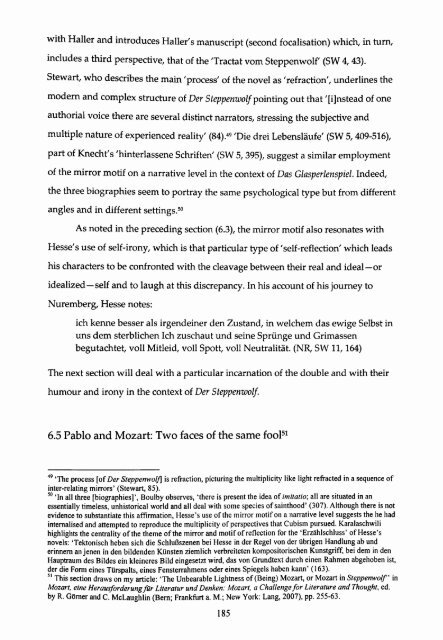HERMANN HESSE AND THE DIALECTICS OF TIME Salvatore C. P. ...
HERMANN HESSE AND THE DIALECTICS OF TIME Salvatore C. P. ...
HERMANN HESSE AND THE DIALECTICS OF TIME Salvatore C. P. ...
You also want an ePaper? Increase the reach of your titles
YUMPU automatically turns print PDFs into web optimized ePapers that Google loves.
with Haller and introduces Haller/s manuscript (second focalisation) which, in turn,<br />
includes a third perspective, that of the Tractat vom Steppenwolf (SW 4, 43).<br />
Stewart, who describes the main 'process' of the novel as 'refraction 7, underlines the<br />
modern and complex structure of Der Steppenwolf pointing out that '[i]nstead of one<br />
authorial voice there are several distinct narrators, stressing the subjective and<br />
multiple nature of experienced reality7 (84). 49 'Die drei Lebenslaufe' (SW 5, 409-516),<br />
part of Knecht's 'hinterlassene Schriften 7 (SW 5, 395), suggest a similar employment<br />
of the mirror motif on a narrative level in the context of Das Glasperlenspiel. Indeed,<br />
the three biographies seem to portray the same psychological type but from different<br />
angles and in different settings. 50<br />
As noted in the preceding section (6.3), the mirror motif also resonates with<br />
Hesse's use of self-irony, which is that particular type of 'self-reflection' which leads<br />
his characters to be confronted with the cleavage between their real and ideal or<br />
idealized self and to laugh at this discrepancy. In his account of his journey to<br />
Nuremberg, Hesse notes:<br />
ich kenne besser als irgendeiner den Zustand, in welchem das ewige Selbst in<br />
uns dem sterblichen Ich zuschaut und seine Spriinge und Grimassen<br />
begutachtet, voll Mitleid, voll Spott, voll Neutralitat. (NR, SW 11,164)<br />
The next section will deal with a particular incarnation of the double and with their<br />
humour and irony in the context of Der Steppenwolf.<br />
6.5 Pablo and Mozart: Two faces of the same fool51<br />
49 The process [of Der Steppenwolf] is refraction, picturing the multiplicity like light refracted in a sequence of<br />
inter-relating mirrors' (Stewart, 85).<br />
50 'In all three [biographies]', Boulby observes, 'there is present the idea ofimitatio', all are situated in an<br />
essentially timeless, unhistorical world and all deal with some species of sainthood' (307). Although there is not<br />
evidence to substantiate this affirmation, Hesse's use of the mirror motif on a narrative level suggests the he had<br />
internalised and attempted to reproduce the multiplicity of perspectives that Cubism pursued. Karalaschwili<br />
highlights the centrality of the theme of the mirror and motif of reflection for the 'Erzahlschluss' of Hesse's<br />
novels: Tektonisch heben sich die SchluBszenen bei Hesse in der Regel von der ubrigen Handlung ab und<br />
erinnern an jenen in den bildenden Kunsten ziemlich verbreiteten kompositorischen Kunstgriff, bei dem in den<br />
Hauptraum des Bildes ein kleineres Bild eingesetzt wird, das von Grundtext durch einen Rahmen abgehoben ist,<br />
der die Form eines TUrspalts, eines Fensterrahmens oder eines Spiegels haben kann' (163).<br />
51 This section draws on my article: The Unbearable Lightness of (Being) Mozart, or Mozart in Steppenwolf in<br />
Mozart, eine Herausforderungfur Literatur undDenken: Mozart, a Challenge for Literature and Thought, ed.<br />
by R. G6rner and C. McLaughlin (Bern; Frankfurt a. M.; New York: Lang, 2007), pp. 255-63.<br />
185
















